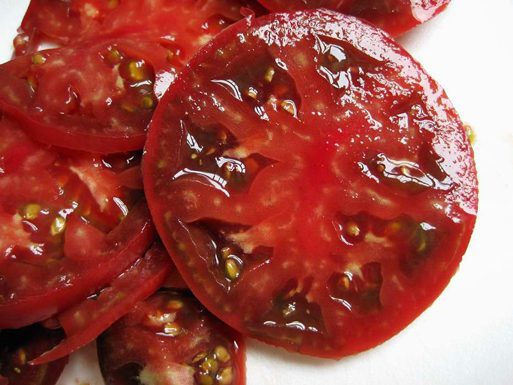Avoiding the tomato-industrial complex

This time of year, I’m trying to get my fill of fresh tomatoes from the farmers market and my parents’ garden in the Uwharries. As fall approaches, I start to crave heartier food and switch to recipes that call for canned tomatoes. I rarely buy fresh tomatoes out of season, but when I’m eating out, I generally accept them on a sandwich or salad. They don’t offer much in the way of taste, but I used to believe they at least provided a little nutrition.
Little nutrition is more like it. The U.S. Department of Agriculture compared the nutritional values of today’s industrial tomatoes to ones grown in the 1960s. The results? Levels of vitamin C, thiamin, niacin and calcium have declined. Even worse, they now have 14 times more sodium. Excuse me, but if I want more sodium in my diet, I’m going to eat potato chips.
This is one of the many shocking facts I learned in Barry Estabrook’s recent book Tomatoland. Fresh tomatoes in the grocery store are typically grown in Florida. They’re picked hard and green then turned a cosmetic red with a blast of ethylene gas. Florida’s climate might be nice for retirees and tourists, but it’s tough on tomatoes. The sandy soil is devoid of nutrients, so plants are plied with fertilizer. Humidity makes them vulnerable to all sorts of pests, so an arsenal of chemicals is deployed to combat them. This can prove fatal to local wildlife, especially birds, reptiles and fish. Tomatoes fare much better in California, the center of the canned tomato industry, where the climate is similar to their native habitat in South America.
 There are also tragic human costs associated with Florida tomatoes. Field hands working in close proximity to toxic chemicals suffer an array of health problems. Estabrook describes a cluster of horrific birth defects in a single labor camp. Workers can also be subjected to inhumane conditions. Several cases of slavery have been successfully prosecuted in recent years. Degrading people and the environment for the sake of tasteless tomatoes – it seems like a terrible waste.
There are also tragic human costs associated with Florida tomatoes. Field hands working in close proximity to toxic chemicals suffer an array of health problems. Estabrook describes a cluster of horrific birth defects in a single labor camp. Workers can also be subjected to inhumane conditions. Several cases of slavery have been successfully prosecuted in recent years. Degrading people and the environment for the sake of tasteless tomatoes – it seems like a terrible waste.
Fortunately, tomatoes do well here in the Piedmont. We can grow our own and pick our own and slice our own and relish them – free of pesticides and with a free conscience. Our red clay makes them taste like something special, and our season is fairly long. In the Uwharries, it’s a point of pride to pick your first tomato by the Fourth of July. With the right varieties and a willingness to do a little extra work, that’s easily achievable. Some varieties produce until frost. Thanks to a renewed interest in heirlooms, there are dozens to choose from these days. I love a Black Cherry or Cherokee Purple, but I’m also happy with hybrids like Sun Gold or Celebrity.
Even with a hearty appetite and a stack of recipes, it’s hard to keep up with tomatoes at their peak in July and August. Many people in the Uwharries go to some trouble to put them up in one way or another. I grew up watching, and sometimes helping, my mom can all sorts of vegetables. The pressure cooker always made me a little nervous – all that volatile hissing and jiggling – so I appreciated that tomatoes were satisfied with a hot bath in the canner. It’s still a dreadful amount of work – all that cleaning, boiling, peeling, packing and lifting. Mama generally freezes a few to use in soups and stews. It’s easier, but the texture can be less than inspiring.
Last fall, she sent me home with a bag of Long Keepers, a variety that produces late in the season and ripens slowly after being picked. I had no idea what I’d do with them – salad season was over for me – but I dutifully let them ripen on my windowsill. After researching recipes on the internet, I decided to roast them. I didn’t mind running my oven for a few hours during the first cold snap in early October. I packed them in a little olive oil, and they kept in the fridge for weeks.
My friend Kent bought a food dehydrator this summer. He slices or halves his tomatoes, lays them out on racks and sets a timer. Twenty-six hours later, he dumps them in a jar or plastic bag. Pureed tomatoes can be dried into sheets of “leather” then rolled up and used as tomato paste. Best of all, dried fruits and vegetables take up much less space in the cabinet or freezer.
OK, I’m sold. I ordered one on-line and had it shipped to the Uwharries. Before the season ends, I’ll have another way to put up some local tomatoes so I can savor them all year.
Click here for some recipes you can use with your summer tomatoes.
Link to water-bath canning information.
Photographs by Kent Thompson